Auditing and Assurance Services
VerifiedAdded on 2023/06/07
|14
|3665
|300
AI Summary
This report aims at the assessment of the assertion risks from the provided companies; they are Computing Solution and Beautiful Hair. The first part of the report helps in the identification of the major assertion risks in the provide scenario. After that, the next part shows the application of different s...
Read More
Contribute Materials
Your contribution can guide someone’s learning journey. Share your
documents today.
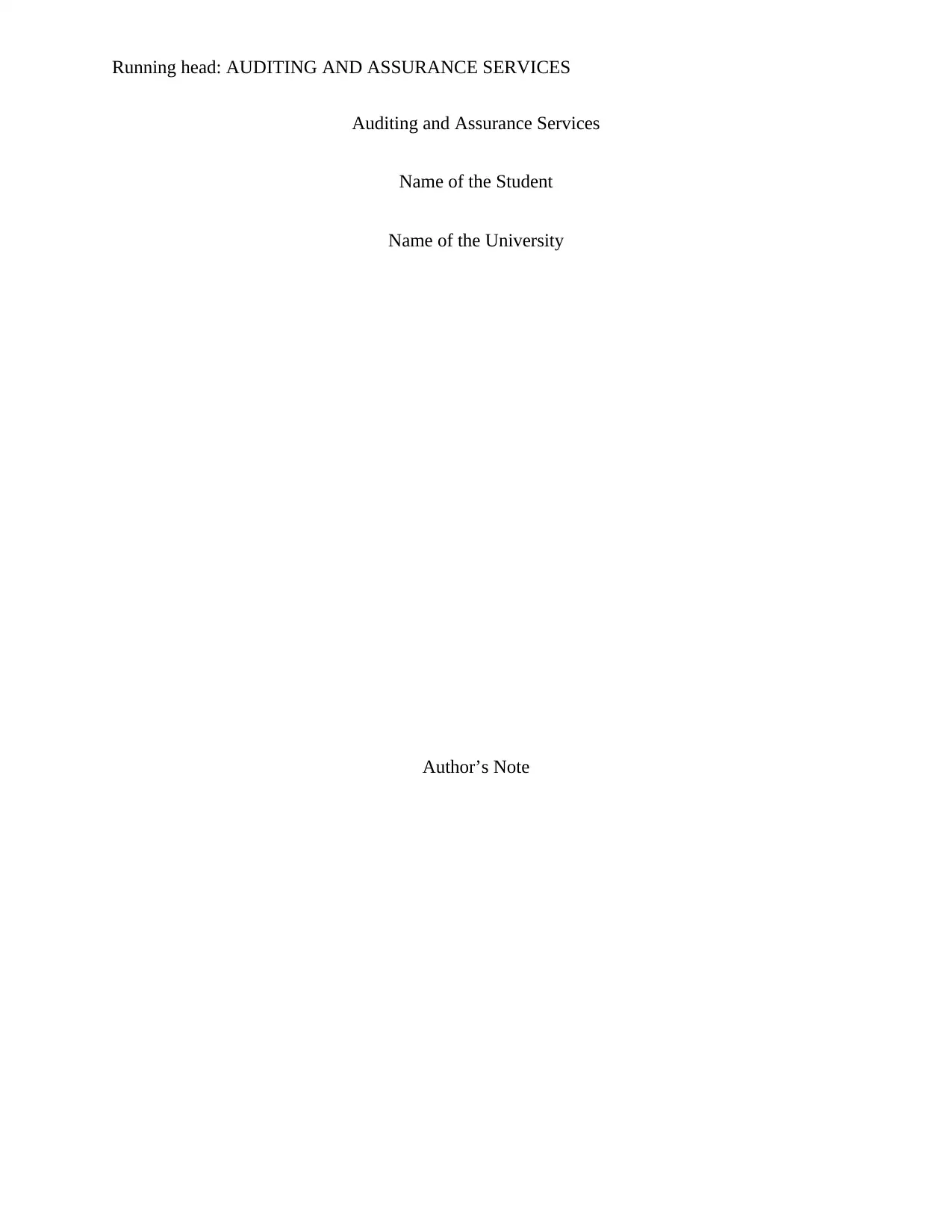
Running head: AUDITING AND ASSURANCE SERVICES
Auditing and Assurance Services
Name of the Student
Name of the University
Author’s Note
Auditing and Assurance Services
Name of the Student
Name of the University
Author’s Note
Secure Best Marks with AI Grader
Need help grading? Try our AI Grader for instant feedback on your assignments.
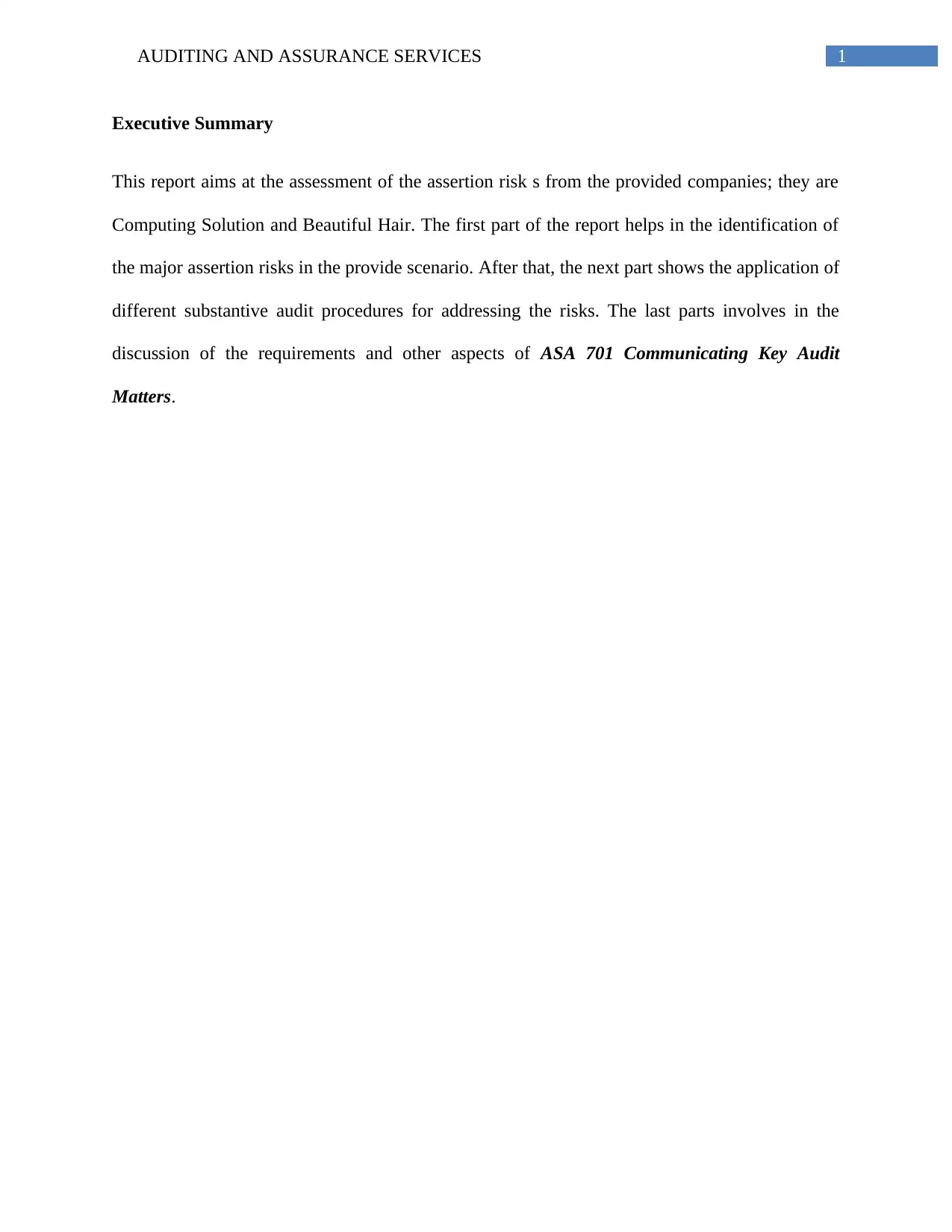
1AUDITING AND ASSURANCE SERVICES
Executive Summary
This report aims at the assessment of the assertion risk s from the provided companies; they are
Computing Solution and Beautiful Hair. The first part of the report helps in the identification of
the major assertion risks in the provide scenario. After that, the next part shows the application of
different substantive audit procedures for addressing the risks. The last parts involves in the
discussion of the requirements and other aspects of ASA 701 Communicating Key Audit
Matters.
Executive Summary
This report aims at the assessment of the assertion risk s from the provided companies; they are
Computing Solution and Beautiful Hair. The first part of the report helps in the identification of
the major assertion risks in the provide scenario. After that, the next part shows the application of
different substantive audit procedures for addressing the risks. The last parts involves in the
discussion of the requirements and other aspects of ASA 701 Communicating Key Audit
Matters.
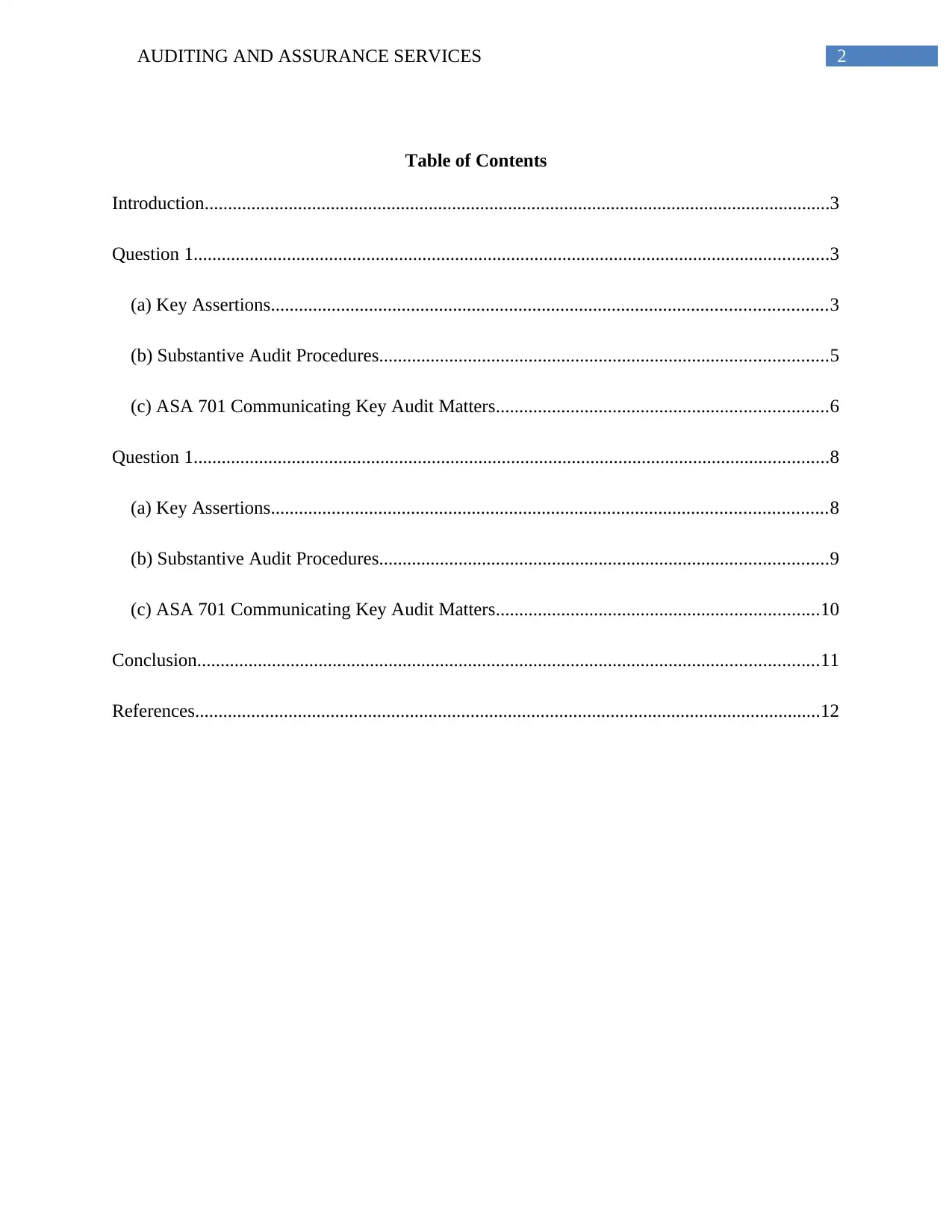
2AUDITING AND ASSURANCE SERVICES
Table of Contents
Introduction......................................................................................................................................3
Question 1........................................................................................................................................3
(a) Key Assertions.......................................................................................................................3
(b) Substantive Audit Procedures................................................................................................5
(c) ASA 701 Communicating Key Audit Matters.......................................................................6
Question 1........................................................................................................................................8
(a) Key Assertions.......................................................................................................................8
(b) Substantive Audit Procedures................................................................................................9
(c) ASA 701 Communicating Key Audit Matters.....................................................................10
Conclusion.....................................................................................................................................11
References......................................................................................................................................12
Table of Contents
Introduction......................................................................................................................................3
Question 1........................................................................................................................................3
(a) Key Assertions.......................................................................................................................3
(b) Substantive Audit Procedures................................................................................................5
(c) ASA 701 Communicating Key Audit Matters.......................................................................6
Question 1........................................................................................................................................8
(a) Key Assertions.......................................................................................................................8
(b) Substantive Audit Procedures................................................................................................9
(c) ASA 701 Communicating Key Audit Matters.....................................................................10
Conclusion.....................................................................................................................................11
References......................................................................................................................................12
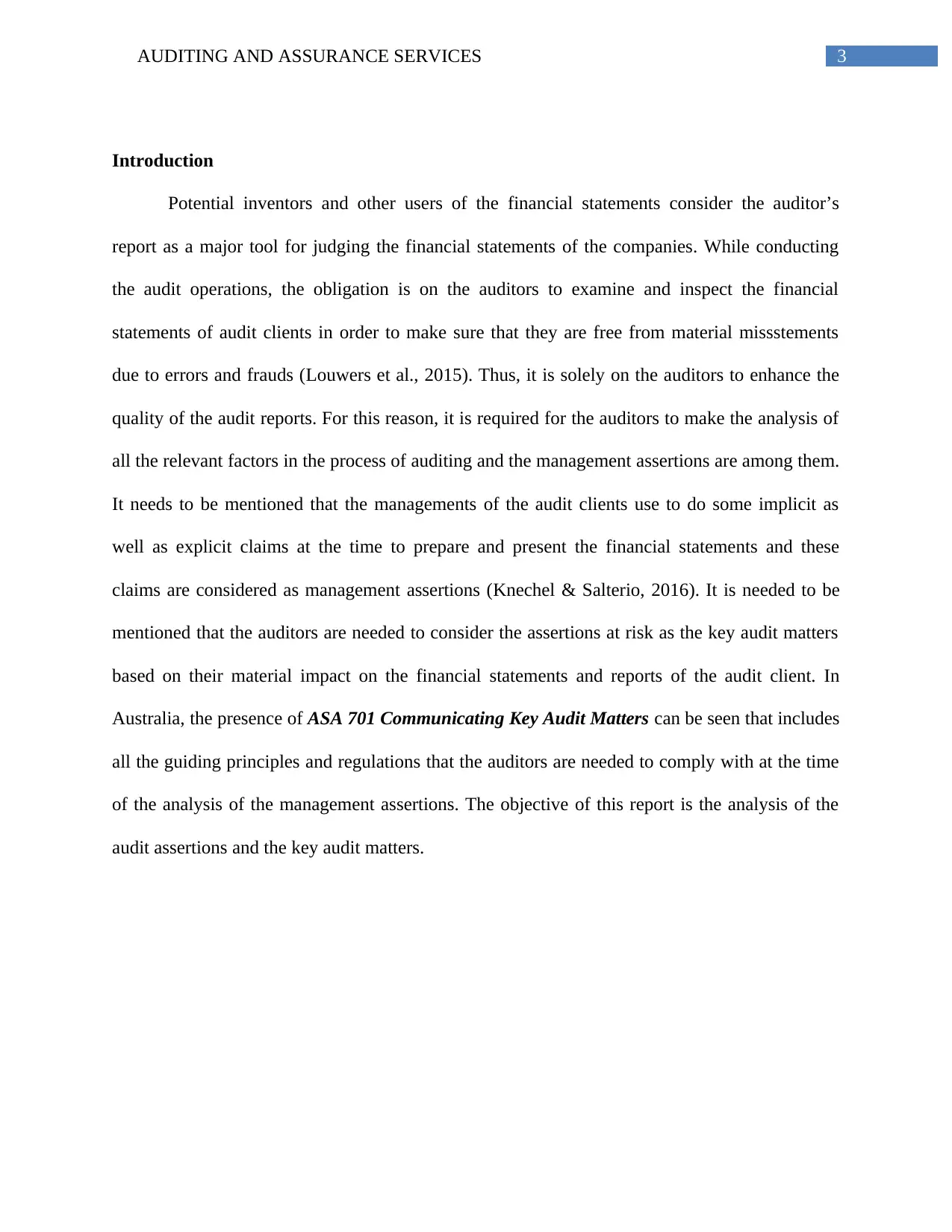
3AUDITING AND ASSURANCE SERVICES
Introduction
Potential inventors and other users of the financial statements consider the auditor’s
report as a major tool for judging the financial statements of the companies. While conducting
the audit operations, the obligation is on the auditors to examine and inspect the financial
statements of audit clients in order to make sure that they are free from material missstements
due to errors and frauds (Louwers et al., 2015). Thus, it is solely on the auditors to enhance the
quality of the audit reports. For this reason, it is required for the auditors to make the analysis of
all the relevant factors in the process of auditing and the management assertions are among them.
It needs to be mentioned that the managements of the audit clients use to do some implicit as
well as explicit claims at the time to prepare and present the financial statements and these
claims are considered as management assertions (Knechel & Salterio, 2016). It is needed to be
mentioned that the auditors are needed to consider the assertions at risk as the key audit matters
based on their material impact on the financial statements and reports of the audit client. In
Australia, the presence of ASA 701 Communicating Key Audit Matters can be seen that includes
all the guiding principles and regulations that the auditors are needed to comply with at the time
of the analysis of the management assertions. The objective of this report is the analysis of the
audit assertions and the key audit matters.
Introduction
Potential inventors and other users of the financial statements consider the auditor’s
report as a major tool for judging the financial statements of the companies. While conducting
the audit operations, the obligation is on the auditors to examine and inspect the financial
statements of audit clients in order to make sure that they are free from material missstements
due to errors and frauds (Louwers et al., 2015). Thus, it is solely on the auditors to enhance the
quality of the audit reports. For this reason, it is required for the auditors to make the analysis of
all the relevant factors in the process of auditing and the management assertions are among them.
It needs to be mentioned that the managements of the audit clients use to do some implicit as
well as explicit claims at the time to prepare and present the financial statements and these
claims are considered as management assertions (Knechel & Salterio, 2016). It is needed to be
mentioned that the auditors are needed to consider the assertions at risk as the key audit matters
based on their material impact on the financial statements and reports of the audit client. In
Australia, the presence of ASA 701 Communicating Key Audit Matters can be seen that includes
all the guiding principles and regulations that the auditors are needed to comply with at the time
of the analysis of the management assertions. The objective of this report is the analysis of the
audit assertions and the key audit matters.
Secure Best Marks with AI Grader
Need help grading? Try our AI Grader for instant feedback on your assignments.
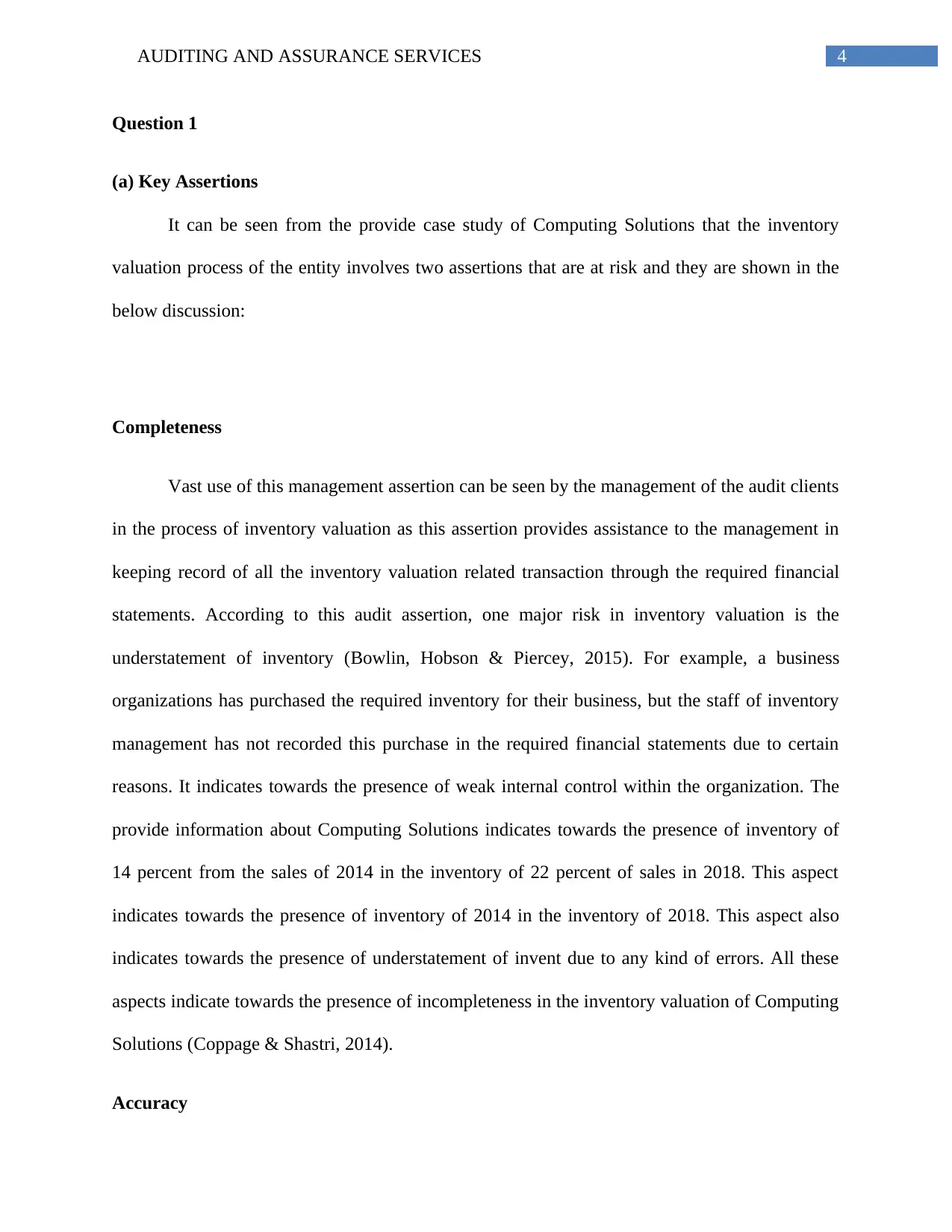
4AUDITING AND ASSURANCE SERVICES
Question 1
(a) Key Assertions
It can be seen from the provide case study of Computing Solutions that the inventory
valuation process of the entity involves two assertions that are at risk and they are shown in the
below discussion:
Completeness
Vast use of this management assertion can be seen by the management of the audit clients
in the process of inventory valuation as this assertion provides assistance to the management in
keeping record of all the inventory valuation related transaction through the required financial
statements. According to this audit assertion, one major risk in inventory valuation is the
understatement of inventory (Bowlin, Hobson & Piercey, 2015). For example, a business
organizations has purchased the required inventory for their business, but the staff of inventory
management has not recorded this purchase in the required financial statements due to certain
reasons. It indicates towards the presence of weak internal control within the organization. The
provide information about Computing Solutions indicates towards the presence of inventory of
14 percent from the sales of 2014 in the inventory of 22 percent of sales in 2018. This aspect
indicates towards the presence of inventory of 2014 in the inventory of 2018. This aspect also
indicates towards the presence of understatement of invent due to any kind of errors. All these
aspects indicate towards the presence of incompleteness in the inventory valuation of Computing
Solutions (Coppage & Shastri, 2014).
Accuracy
Question 1
(a) Key Assertions
It can be seen from the provide case study of Computing Solutions that the inventory
valuation process of the entity involves two assertions that are at risk and they are shown in the
below discussion:
Completeness
Vast use of this management assertion can be seen by the management of the audit clients
in the process of inventory valuation as this assertion provides assistance to the management in
keeping record of all the inventory valuation related transaction through the required financial
statements. According to this audit assertion, one major risk in inventory valuation is the
understatement of inventory (Bowlin, Hobson & Piercey, 2015). For example, a business
organizations has purchased the required inventory for their business, but the staff of inventory
management has not recorded this purchase in the required financial statements due to certain
reasons. It indicates towards the presence of weak internal control within the organization. The
provide information about Computing Solutions indicates towards the presence of inventory of
14 percent from the sales of 2014 in the inventory of 22 percent of sales in 2018. This aspect
indicates towards the presence of inventory of 2014 in the inventory of 2018. This aspect also
indicates towards the presence of understatement of invent due to any kind of errors. All these
aspects indicate towards the presence of incompleteness in the inventory valuation of Computing
Solutions (Coppage & Shastri, 2014).
Accuracy
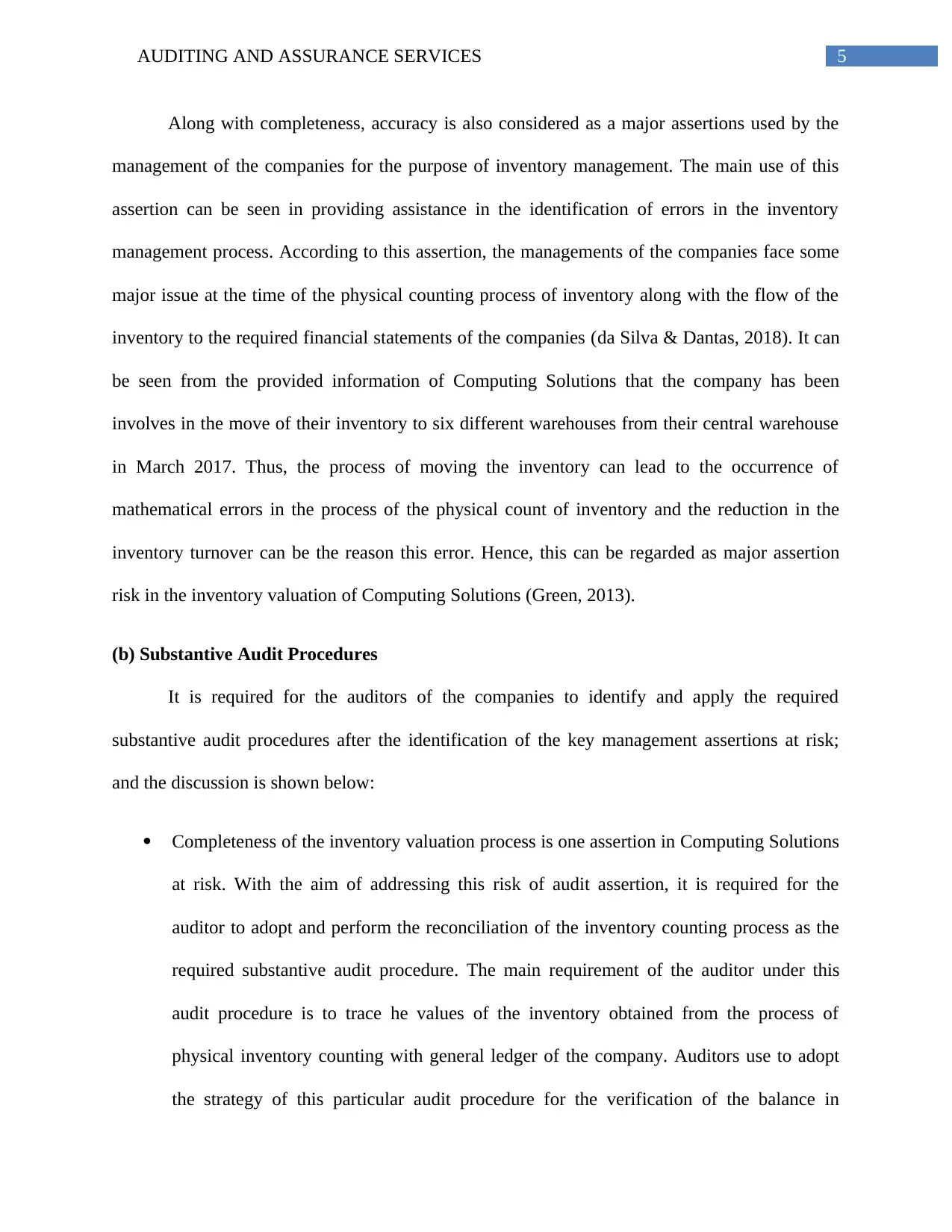
5AUDITING AND ASSURANCE SERVICES
Along with completeness, accuracy is also considered as a major assertions used by the
management of the companies for the purpose of inventory management. The main use of this
assertion can be seen in providing assistance in the identification of errors in the inventory
management process. According to this assertion, the managements of the companies face some
major issue at the time of the physical counting process of inventory along with the flow of the
inventory to the required financial statements of the companies (da Silva & Dantas, 2018). It can
be seen from the provided information of Computing Solutions that the company has been
involves in the move of their inventory to six different warehouses from their central warehouse
in March 2017. Thus, the process of moving the inventory can lead to the occurrence of
mathematical errors in the process of the physical count of inventory and the reduction in the
inventory turnover can be the reason this error. Hence, this can be regarded as major assertion
risk in the inventory valuation of Computing Solutions (Green, 2013).
(b) Substantive Audit Procedures
It is required for the auditors of the companies to identify and apply the required
substantive audit procedures after the identification of the key management assertions at risk;
and the discussion is shown below:
Completeness of the inventory valuation process is one assertion in Computing Solutions
at risk. With the aim of addressing this risk of audit assertion, it is required for the
auditor to adopt and perform the reconciliation of the inventory counting process as the
required substantive audit procedure. The main requirement of the auditor under this
audit procedure is to trace he values of the inventory obtained from the process of
physical inventory counting with general ledger of the company. Auditors use to adopt
the strategy of this particular audit procedure for the verification of the balance in
Along with completeness, accuracy is also considered as a major assertions used by the
management of the companies for the purpose of inventory management. The main use of this
assertion can be seen in providing assistance in the identification of errors in the inventory
management process. According to this assertion, the managements of the companies face some
major issue at the time of the physical counting process of inventory along with the flow of the
inventory to the required financial statements of the companies (da Silva & Dantas, 2018). It can
be seen from the provided information of Computing Solutions that the company has been
involves in the move of their inventory to six different warehouses from their central warehouse
in March 2017. Thus, the process of moving the inventory can lead to the occurrence of
mathematical errors in the process of the physical count of inventory and the reduction in the
inventory turnover can be the reason this error. Hence, this can be regarded as major assertion
risk in the inventory valuation of Computing Solutions (Green, 2013).
(b) Substantive Audit Procedures
It is required for the auditors of the companies to identify and apply the required
substantive audit procedures after the identification of the key management assertions at risk;
and the discussion is shown below:
Completeness of the inventory valuation process is one assertion in Computing Solutions
at risk. With the aim of addressing this risk of audit assertion, it is required for the
auditor to adopt and perform the reconciliation of the inventory counting process as the
required substantive audit procedure. The main requirement of the auditor under this
audit procedure is to trace he values of the inventory obtained from the process of
physical inventory counting with general ledger of the company. Auditors use to adopt
the strategy of this particular audit procedure for the verification of the balance in
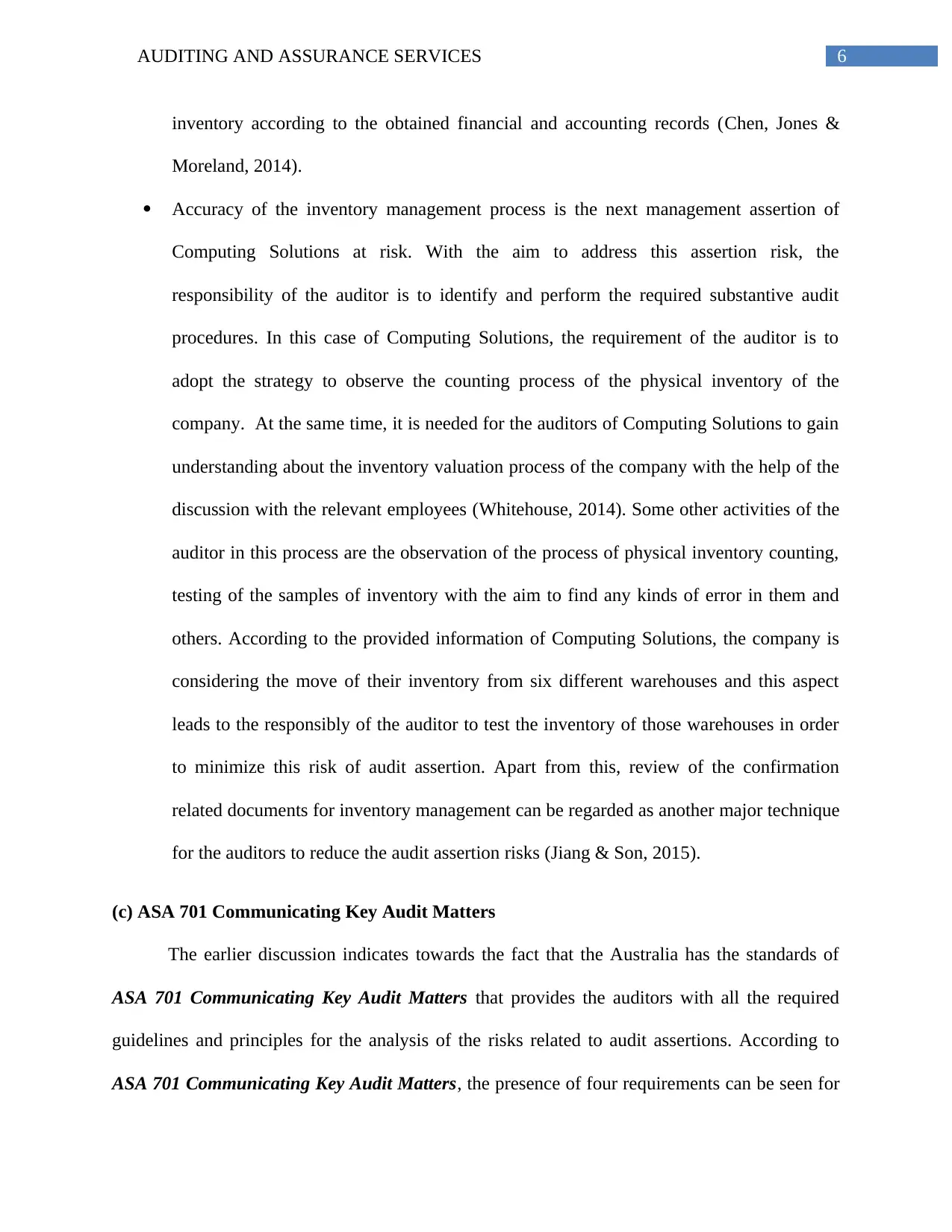
6AUDITING AND ASSURANCE SERVICES
inventory according to the obtained financial and accounting records (Chen, Jones &
Moreland, 2014).
Accuracy of the inventory management process is the next management assertion of
Computing Solutions at risk. With the aim to address this assertion risk, the
responsibility of the auditor is to identify and perform the required substantive audit
procedures. In this case of Computing Solutions, the requirement of the auditor is to
adopt the strategy to observe the counting process of the physical inventory of the
company. At the same time, it is needed for the auditors of Computing Solutions to gain
understanding about the inventory valuation process of the company with the help of the
discussion with the relevant employees (Whitehouse, 2014). Some other activities of the
auditor in this process are the observation of the process of physical inventory counting,
testing of the samples of inventory with the aim to find any kinds of error in them and
others. According to the provided information of Computing Solutions, the company is
considering the move of their inventory from six different warehouses and this aspect
leads to the responsibly of the auditor to test the inventory of those warehouses in order
to minimize this risk of audit assertion. Apart from this, review of the confirmation
related documents for inventory management can be regarded as another major technique
for the auditors to reduce the audit assertion risks (Jiang & Son, 2015).
(c) ASA 701 Communicating Key Audit Matters
The earlier discussion indicates towards the fact that the Australia has the standards of
ASA 701 Communicating Key Audit Matters that provides the auditors with all the required
guidelines and principles for the analysis of the risks related to audit assertions. According to
ASA 701 Communicating Key Audit Matters, the presence of four requirements can be seen for
inventory according to the obtained financial and accounting records (Chen, Jones &
Moreland, 2014).
Accuracy of the inventory management process is the next management assertion of
Computing Solutions at risk. With the aim to address this assertion risk, the
responsibility of the auditor is to identify and perform the required substantive audit
procedures. In this case of Computing Solutions, the requirement of the auditor is to
adopt the strategy to observe the counting process of the physical inventory of the
company. At the same time, it is needed for the auditors of Computing Solutions to gain
understanding about the inventory valuation process of the company with the help of the
discussion with the relevant employees (Whitehouse, 2014). Some other activities of the
auditor in this process are the observation of the process of physical inventory counting,
testing of the samples of inventory with the aim to find any kinds of error in them and
others. According to the provided information of Computing Solutions, the company is
considering the move of their inventory from six different warehouses and this aspect
leads to the responsibly of the auditor to test the inventory of those warehouses in order
to minimize this risk of audit assertion. Apart from this, review of the confirmation
related documents for inventory management can be regarded as another major technique
for the auditors to reduce the audit assertion risks (Jiang & Son, 2015).
(c) ASA 701 Communicating Key Audit Matters
The earlier discussion indicates towards the fact that the Australia has the standards of
ASA 701 Communicating Key Audit Matters that provides the auditors with all the required
guidelines and principles for the analysis of the risks related to audit assertions. According to
ASA 701 Communicating Key Audit Matters, the presence of four requirements can be seen for
Paraphrase This Document
Need a fresh take? Get an instant paraphrase of this document with our AI Paraphraser
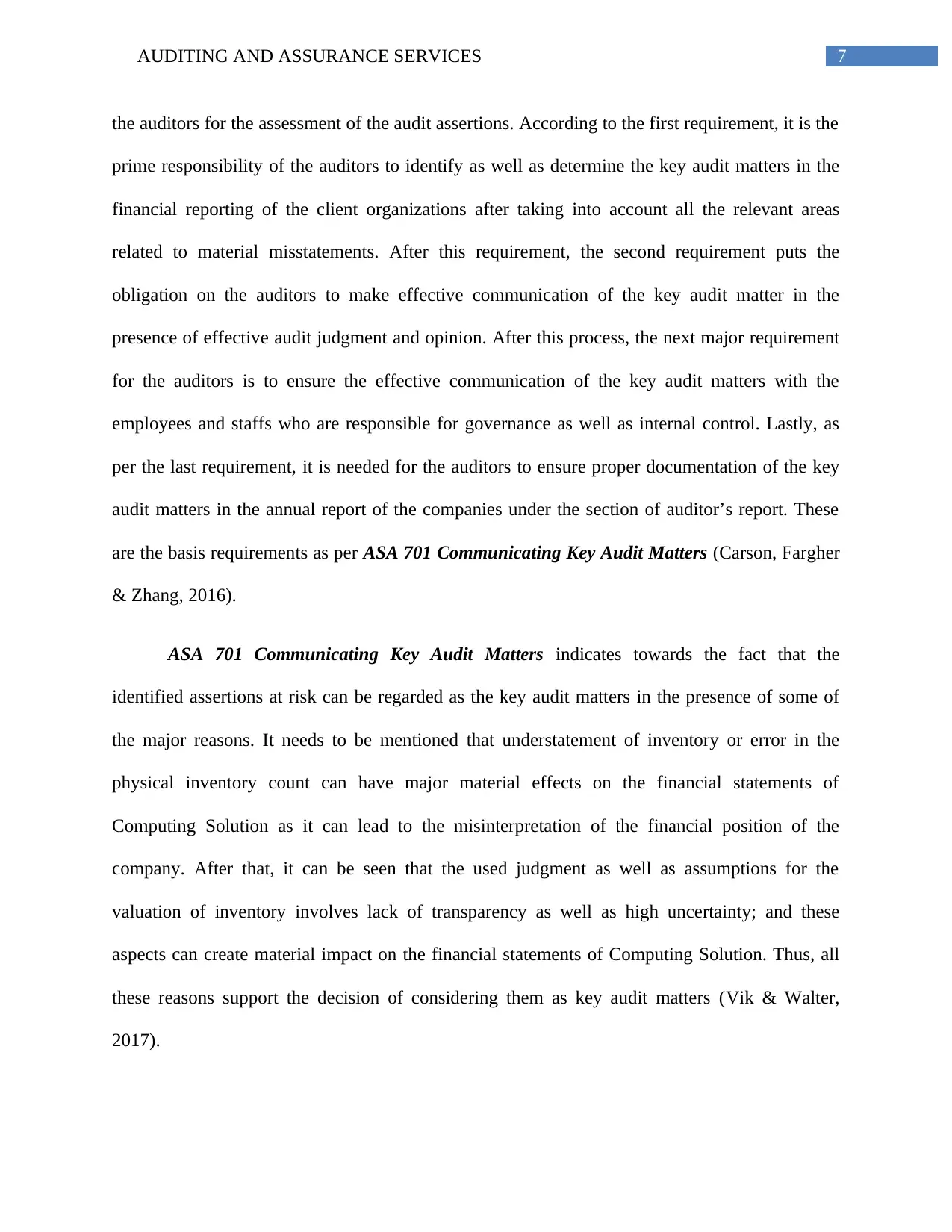
7AUDITING AND ASSURANCE SERVICES
the auditors for the assessment of the audit assertions. According to the first requirement, it is the
prime responsibility of the auditors to identify as well as determine the key audit matters in the
financial reporting of the client organizations after taking into account all the relevant areas
related to material misstatements. After this requirement, the second requirement puts the
obligation on the auditors to make effective communication of the key audit matter in the
presence of effective audit judgment and opinion. After this process, the next major requirement
for the auditors is to ensure the effective communication of the key audit matters with the
employees and staffs who are responsible for governance as well as internal control. Lastly, as
per the last requirement, it is needed for the auditors to ensure proper documentation of the key
audit matters in the annual report of the companies under the section of auditor’s report. These
are the basis requirements as per ASA 701 Communicating Key Audit Matters (Carson, Fargher
& Zhang, 2016).
ASA 701 Communicating Key Audit Matters indicates towards the fact that the
identified assertions at risk can be regarded as the key audit matters in the presence of some of
the major reasons. It needs to be mentioned that understatement of inventory or error in the
physical inventory count can have major material effects on the financial statements of
Computing Solution as it can lead to the misinterpretation of the financial position of the
company. After that, it can be seen that the used judgment as well as assumptions for the
valuation of inventory involves lack of transparency as well as high uncertainty; and these
aspects can create material impact on the financial statements of Computing Solution. Thus, all
these reasons support the decision of considering them as key audit matters (Vik & Walter,
2017).
the auditors for the assessment of the audit assertions. According to the first requirement, it is the
prime responsibility of the auditors to identify as well as determine the key audit matters in the
financial reporting of the client organizations after taking into account all the relevant areas
related to material misstatements. After this requirement, the second requirement puts the
obligation on the auditors to make effective communication of the key audit matter in the
presence of effective audit judgment and opinion. After this process, the next major requirement
for the auditors is to ensure the effective communication of the key audit matters with the
employees and staffs who are responsible for governance as well as internal control. Lastly, as
per the last requirement, it is needed for the auditors to ensure proper documentation of the key
audit matters in the annual report of the companies under the section of auditor’s report. These
are the basis requirements as per ASA 701 Communicating Key Audit Matters (Carson, Fargher
& Zhang, 2016).
ASA 701 Communicating Key Audit Matters indicates towards the fact that the
identified assertions at risk can be regarded as the key audit matters in the presence of some of
the major reasons. It needs to be mentioned that understatement of inventory or error in the
physical inventory count can have major material effects on the financial statements of
Computing Solution as it can lead to the misinterpretation of the financial position of the
company. After that, it can be seen that the used judgment as well as assumptions for the
valuation of inventory involves lack of transparency as well as high uncertainty; and these
aspects can create material impact on the financial statements of Computing Solution. Thus, all
these reasons support the decision of considering them as key audit matters (Vik & Walter,
2017).
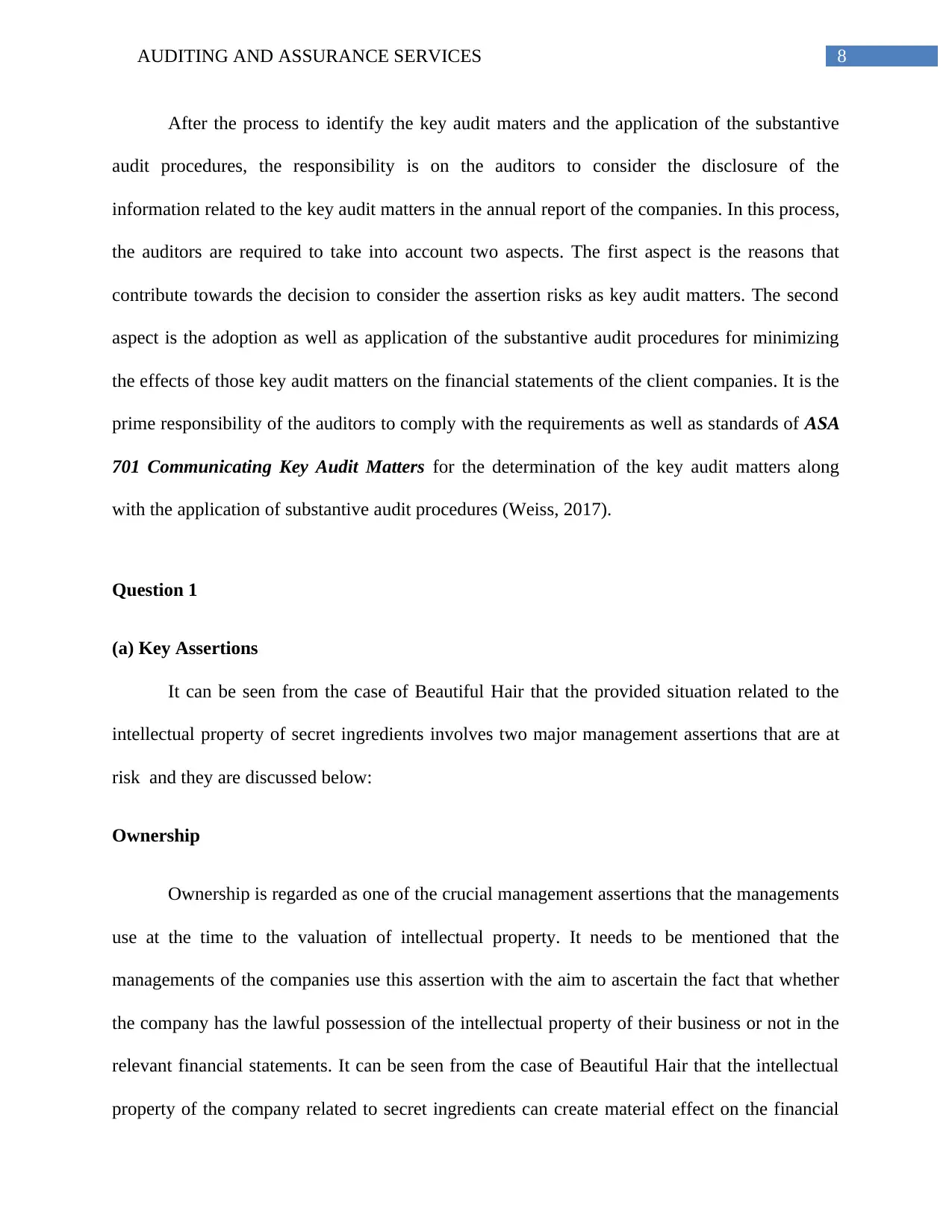
8AUDITING AND ASSURANCE SERVICES
After the process to identify the key audit maters and the application of the substantive
audit procedures, the responsibility is on the auditors to consider the disclosure of the
information related to the key audit matters in the annual report of the companies. In this process,
the auditors are required to take into account two aspects. The first aspect is the reasons that
contribute towards the decision to consider the assertion risks as key audit matters. The second
aspect is the adoption as well as application of the substantive audit procedures for minimizing
the effects of those key audit matters on the financial statements of the client companies. It is the
prime responsibility of the auditors to comply with the requirements as well as standards of ASA
701 Communicating Key Audit Matters for the determination of the key audit matters along
with the application of substantive audit procedures (Weiss, 2017).
Question 1
(a) Key Assertions
It can be seen from the case of Beautiful Hair that the provided situation related to the
intellectual property of secret ingredients involves two major management assertions that are at
risk and they are discussed below:
Ownership
Ownership is regarded as one of the crucial management assertions that the managements
use at the time to the valuation of intellectual property. It needs to be mentioned that the
managements of the companies use this assertion with the aim to ascertain the fact that whether
the company has the lawful possession of the intellectual property of their business or not in the
relevant financial statements. It can be seen from the case of Beautiful Hair that the intellectual
property of the company related to secret ingredients can create material effect on the financial
After the process to identify the key audit maters and the application of the substantive
audit procedures, the responsibility is on the auditors to consider the disclosure of the
information related to the key audit matters in the annual report of the companies. In this process,
the auditors are required to take into account two aspects. The first aspect is the reasons that
contribute towards the decision to consider the assertion risks as key audit matters. The second
aspect is the adoption as well as application of the substantive audit procedures for minimizing
the effects of those key audit matters on the financial statements of the client companies. It is the
prime responsibility of the auditors to comply with the requirements as well as standards of ASA
701 Communicating Key Audit Matters for the determination of the key audit matters along
with the application of substantive audit procedures (Weiss, 2017).
Question 1
(a) Key Assertions
It can be seen from the case of Beautiful Hair that the provided situation related to the
intellectual property of secret ingredients involves two major management assertions that are at
risk and they are discussed below:
Ownership
Ownership is regarded as one of the crucial management assertions that the managements
use at the time to the valuation of intellectual property. It needs to be mentioned that the
managements of the companies use this assertion with the aim to ascertain the fact that whether
the company has the lawful possession of the intellectual property of their business or not in the
relevant financial statements. It can be seen from the case of Beautiful Hair that the intellectual
property of the company related to secret ingredients can create material effect on the financial
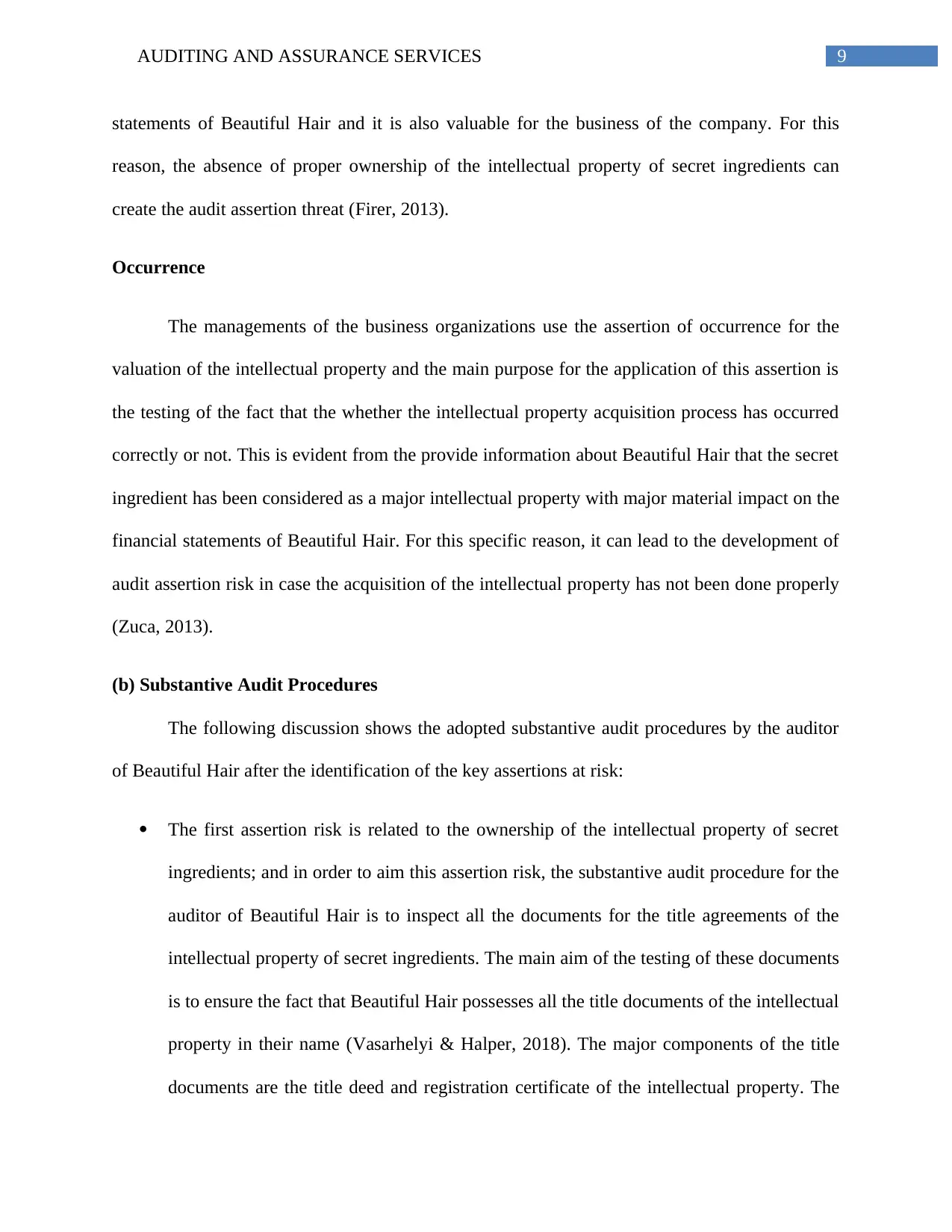
9AUDITING AND ASSURANCE SERVICES
statements of Beautiful Hair and it is also valuable for the business of the company. For this
reason, the absence of proper ownership of the intellectual property of secret ingredients can
create the audit assertion threat (Firer, 2013).
Occurrence
The managements of the business organizations use the assertion of occurrence for the
valuation of the intellectual property and the main purpose for the application of this assertion is
the testing of the fact that the whether the intellectual property acquisition process has occurred
correctly or not. This is evident from the provide information about Beautiful Hair that the secret
ingredient has been considered as a major intellectual property with major material impact on the
financial statements of Beautiful Hair. For this specific reason, it can lead to the development of
audit assertion risk in case the acquisition of the intellectual property has not been done properly
(Zuca, 2013).
(b) Substantive Audit Procedures
The following discussion shows the adopted substantive audit procedures by the auditor
of Beautiful Hair after the identification of the key assertions at risk:
The first assertion risk is related to the ownership of the intellectual property of secret
ingredients; and in order to aim this assertion risk, the substantive audit procedure for the
auditor of Beautiful Hair is to inspect all the documents for the title agreements of the
intellectual property of secret ingredients. The main aim of the testing of these documents
is to ensure the fact that Beautiful Hair possesses all the title documents of the intellectual
property in their name (Vasarhelyi & Halper, 2018). The major components of the title
documents are the title deed and registration certificate of the intellectual property. The
statements of Beautiful Hair and it is also valuable for the business of the company. For this
reason, the absence of proper ownership of the intellectual property of secret ingredients can
create the audit assertion threat (Firer, 2013).
Occurrence
The managements of the business organizations use the assertion of occurrence for the
valuation of the intellectual property and the main purpose for the application of this assertion is
the testing of the fact that the whether the intellectual property acquisition process has occurred
correctly or not. This is evident from the provide information about Beautiful Hair that the secret
ingredient has been considered as a major intellectual property with major material impact on the
financial statements of Beautiful Hair. For this specific reason, it can lead to the development of
audit assertion risk in case the acquisition of the intellectual property has not been done properly
(Zuca, 2013).
(b) Substantive Audit Procedures
The following discussion shows the adopted substantive audit procedures by the auditor
of Beautiful Hair after the identification of the key assertions at risk:
The first assertion risk is related to the ownership of the intellectual property of secret
ingredients; and in order to aim this assertion risk, the substantive audit procedure for the
auditor of Beautiful Hair is to inspect all the documents for the title agreements of the
intellectual property of secret ingredients. The main aim of the testing of these documents
is to ensure the fact that Beautiful Hair possesses all the title documents of the intellectual
property in their name (Vasarhelyi & Halper, 2018). The major components of the title
documents are the title deed and registration certificate of the intellectual property. The
Secure Best Marks with AI Grader
Need help grading? Try our AI Grader for instant feedback on your assignments.
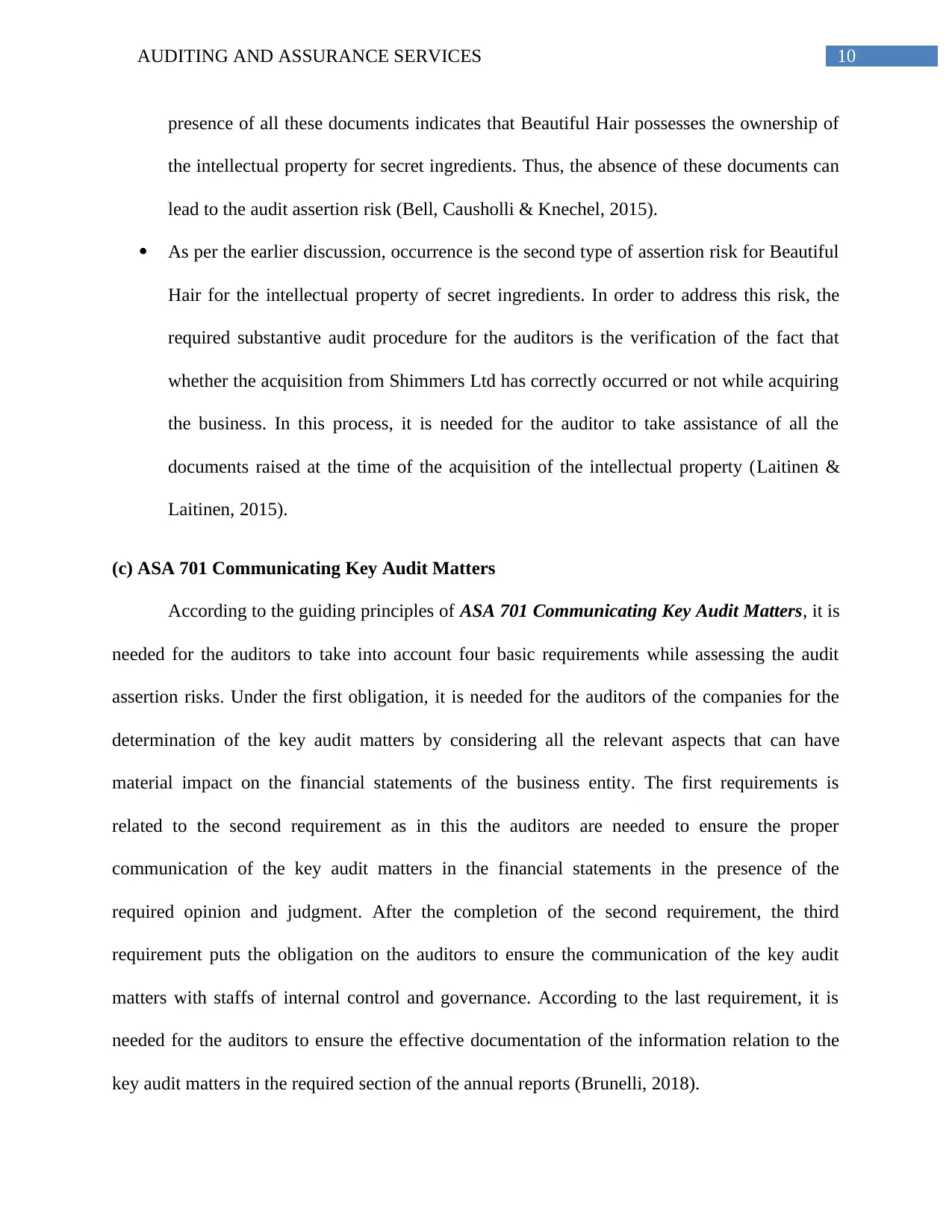
10AUDITING AND ASSURANCE SERVICES
presence of all these documents indicates that Beautiful Hair possesses the ownership of
the intellectual property for secret ingredients. Thus, the absence of these documents can
lead to the audit assertion risk (Bell, Causholli & Knechel, 2015).
As per the earlier discussion, occurrence is the second type of assertion risk for Beautiful
Hair for the intellectual property of secret ingredients. In order to address this risk, the
required substantive audit procedure for the auditors is the verification of the fact that
whether the acquisition from Shimmers Ltd has correctly occurred or not while acquiring
the business. In this process, it is needed for the auditor to take assistance of all the
documents raised at the time of the acquisition of the intellectual property (Laitinen &
Laitinen, 2015).
(c) ASA 701 Communicating Key Audit Matters
According to the guiding principles of ASA 701 Communicating Key Audit Matters, it is
needed for the auditors to take into account four basic requirements while assessing the audit
assertion risks. Under the first obligation, it is needed for the auditors of the companies for the
determination of the key audit matters by considering all the relevant aspects that can have
material impact on the financial statements of the business entity. The first requirements is
related to the second requirement as in this the auditors are needed to ensure the proper
communication of the key audit matters in the financial statements in the presence of the
required opinion and judgment. After the completion of the second requirement, the third
requirement puts the obligation on the auditors to ensure the communication of the key audit
matters with staffs of internal control and governance. According to the last requirement, it is
needed for the auditors to ensure the effective documentation of the information relation to the
key audit matters in the required section of the annual reports (Brunelli, 2018).
presence of all these documents indicates that Beautiful Hair possesses the ownership of
the intellectual property for secret ingredients. Thus, the absence of these documents can
lead to the audit assertion risk (Bell, Causholli & Knechel, 2015).
As per the earlier discussion, occurrence is the second type of assertion risk for Beautiful
Hair for the intellectual property of secret ingredients. In order to address this risk, the
required substantive audit procedure for the auditors is the verification of the fact that
whether the acquisition from Shimmers Ltd has correctly occurred or not while acquiring
the business. In this process, it is needed for the auditor to take assistance of all the
documents raised at the time of the acquisition of the intellectual property (Laitinen &
Laitinen, 2015).
(c) ASA 701 Communicating Key Audit Matters
According to the guiding principles of ASA 701 Communicating Key Audit Matters, it is
needed for the auditors to take into account four basic requirements while assessing the audit
assertion risks. Under the first obligation, it is needed for the auditors of the companies for the
determination of the key audit matters by considering all the relevant aspects that can have
material impact on the financial statements of the business entity. The first requirements is
related to the second requirement as in this the auditors are needed to ensure the proper
communication of the key audit matters in the financial statements in the presence of the
required opinion and judgment. After the completion of the second requirement, the third
requirement puts the obligation on the auditors to ensure the communication of the key audit
matters with staffs of internal control and governance. According to the last requirement, it is
needed for the auditors to ensure the effective documentation of the information relation to the
key audit matters in the required section of the annual reports (Brunelli, 2018).
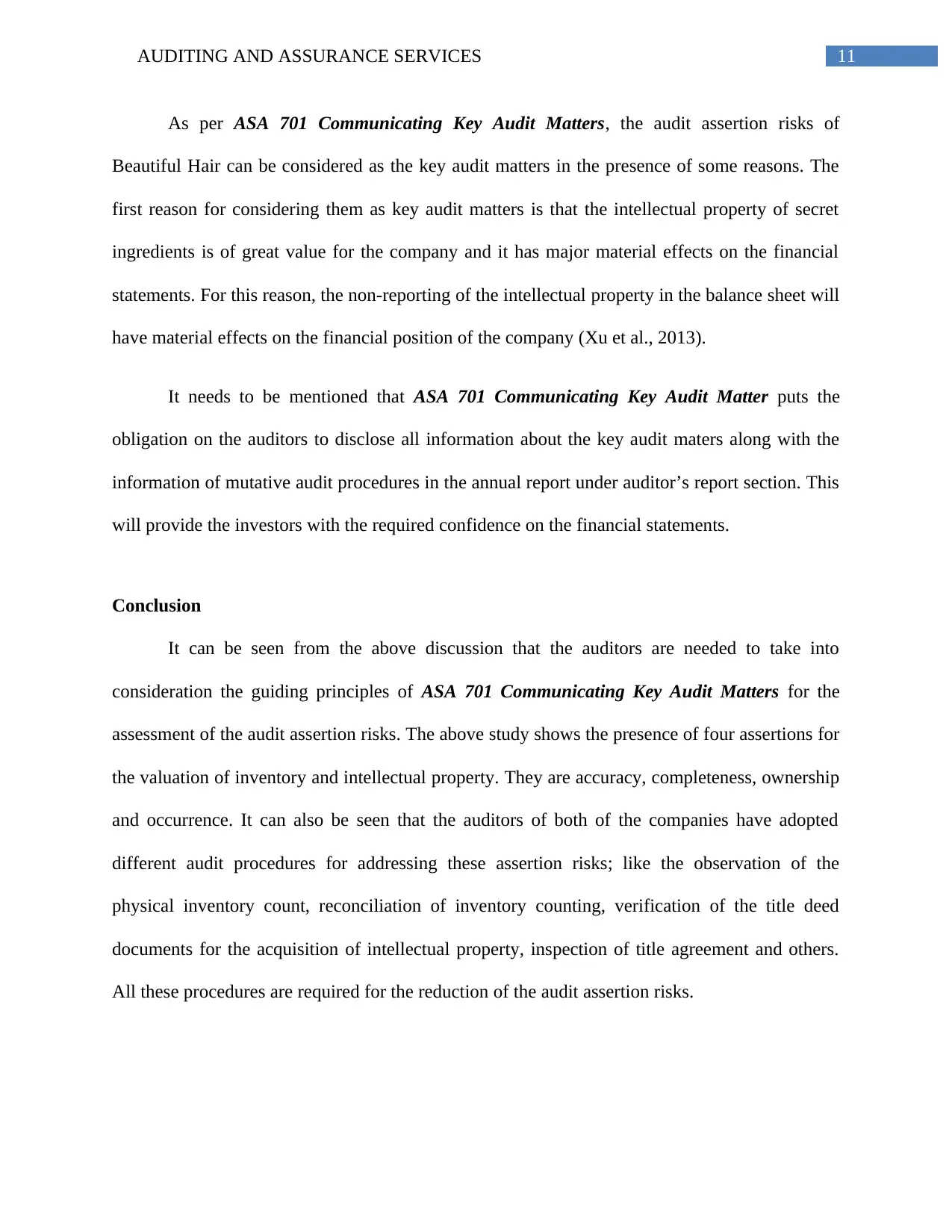
11AUDITING AND ASSURANCE SERVICES
As per ASA 701 Communicating Key Audit Matters, the audit assertion risks of
Beautiful Hair can be considered as the key audit matters in the presence of some reasons. The
first reason for considering them as key audit matters is that the intellectual property of secret
ingredients is of great value for the company and it has major material effects on the financial
statements. For this reason, the non-reporting of the intellectual property in the balance sheet will
have material effects on the financial position of the company (Xu et al., 2013).
It needs to be mentioned that ASA 701 Communicating Key Audit Matter puts the
obligation on the auditors to disclose all information about the key audit maters along with the
information of mutative audit procedures in the annual report under auditor’s report section. This
will provide the investors with the required confidence on the financial statements.
Conclusion
It can be seen from the above discussion that the auditors are needed to take into
consideration the guiding principles of ASA 701 Communicating Key Audit Matters for the
assessment of the audit assertion risks. The above study shows the presence of four assertions for
the valuation of inventory and intellectual property. They are accuracy, completeness, ownership
and occurrence. It can also be seen that the auditors of both of the companies have adopted
different audit procedures for addressing these assertion risks; like the observation of the
physical inventory count, reconciliation of inventory counting, verification of the title deed
documents for the acquisition of intellectual property, inspection of title agreement and others.
All these procedures are required for the reduction of the audit assertion risks.
As per ASA 701 Communicating Key Audit Matters, the audit assertion risks of
Beautiful Hair can be considered as the key audit matters in the presence of some reasons. The
first reason for considering them as key audit matters is that the intellectual property of secret
ingredients is of great value for the company and it has major material effects on the financial
statements. For this reason, the non-reporting of the intellectual property in the balance sheet will
have material effects on the financial position of the company (Xu et al., 2013).
It needs to be mentioned that ASA 701 Communicating Key Audit Matter puts the
obligation on the auditors to disclose all information about the key audit maters along with the
information of mutative audit procedures in the annual report under auditor’s report section. This
will provide the investors with the required confidence on the financial statements.
Conclusion
It can be seen from the above discussion that the auditors are needed to take into
consideration the guiding principles of ASA 701 Communicating Key Audit Matters for the
assessment of the audit assertion risks. The above study shows the presence of four assertions for
the valuation of inventory and intellectual property. They are accuracy, completeness, ownership
and occurrence. It can also be seen that the auditors of both of the companies have adopted
different audit procedures for addressing these assertion risks; like the observation of the
physical inventory count, reconciliation of inventory counting, verification of the title deed
documents for the acquisition of intellectual property, inspection of title agreement and others.
All these procedures are required for the reduction of the audit assertion risks.

12AUDITING AND ASSURANCE SERVICES
References
Bell, T. B., Causholli, M., & Knechel, W. R. (2015). Audit firm tenure, non‐audit services, and
internal assessments of audit quality. Journal of Accounting Research, 53(3), 461-509.
Bowlin, K. O., Hobson, J. L., & Piercey, M. D. (2015). The effects of auditor rotation,
professional skepticism, and interactions with managers on audit quality. The Accounting
Review, 90(4), 1363-1393.
Brunelli, S. (2018). The Firm’Going Concern in the Contemporary Era. In Audit Reporting for
Going Concern Uncertainty (pp. 1-25). Springer, Cham.
Carson, E., Fargher, N., & Zhang, Y. (2016). Trends in auditor reporting in Australia: a synthesis
and opportunities for research. Australian Accounting Review, 26(3), 226-242.
Chen, C. C., Jones, K. T., & Moreland, K. (2014). Differences in learning styles. The CPA
Journal, 84(8), 46.
Coppage, R., & Shastri, T. (2014). Effectively Applying Professional Skepticism to Improve
Audit Quality. The CPA Journal, 84(8), 24.
da Silva, T. C., & Dantas, J. A. (2018). Audit Assertions and Change of Auditors' Opinion in the
Brazilian Market. Revista de Educação e Pesquisa em Contabilidade, 12(1).
Firer, S. (2013). Independent Audit v Independent Review: company law. Without
Prejudice, 13(2), 34-35.
Green, W. J. (2013). Key Considerations in the Audit of Inventory: A Practice-Oriented
Learning Case Utilizing “Diamonds”. Issues in Accounting Education, 28(4), 945-964.
References
Bell, T. B., Causholli, M., & Knechel, W. R. (2015). Audit firm tenure, non‐audit services, and
internal assessments of audit quality. Journal of Accounting Research, 53(3), 461-509.
Bowlin, K. O., Hobson, J. L., & Piercey, M. D. (2015). The effects of auditor rotation,
professional skepticism, and interactions with managers on audit quality. The Accounting
Review, 90(4), 1363-1393.
Brunelli, S. (2018). The Firm’Going Concern in the Contemporary Era. In Audit Reporting for
Going Concern Uncertainty (pp. 1-25). Springer, Cham.
Carson, E., Fargher, N., & Zhang, Y. (2016). Trends in auditor reporting in Australia: a synthesis
and opportunities for research. Australian Accounting Review, 26(3), 226-242.
Chen, C. C., Jones, K. T., & Moreland, K. (2014). Differences in learning styles. The CPA
Journal, 84(8), 46.
Coppage, R., & Shastri, T. (2014). Effectively Applying Professional Skepticism to Improve
Audit Quality. The CPA Journal, 84(8), 24.
da Silva, T. C., & Dantas, J. A. (2018). Audit Assertions and Change of Auditors' Opinion in the
Brazilian Market. Revista de Educação e Pesquisa em Contabilidade, 12(1).
Firer, S. (2013). Independent Audit v Independent Review: company law. Without
Prejudice, 13(2), 34-35.
Green, W. J. (2013). Key Considerations in the Audit of Inventory: A Practice-Oriented
Learning Case Utilizing “Diamonds”. Issues in Accounting Education, 28(4), 945-964.
Paraphrase This Document
Need a fresh take? Get an instant paraphrase of this document with our AI Paraphraser
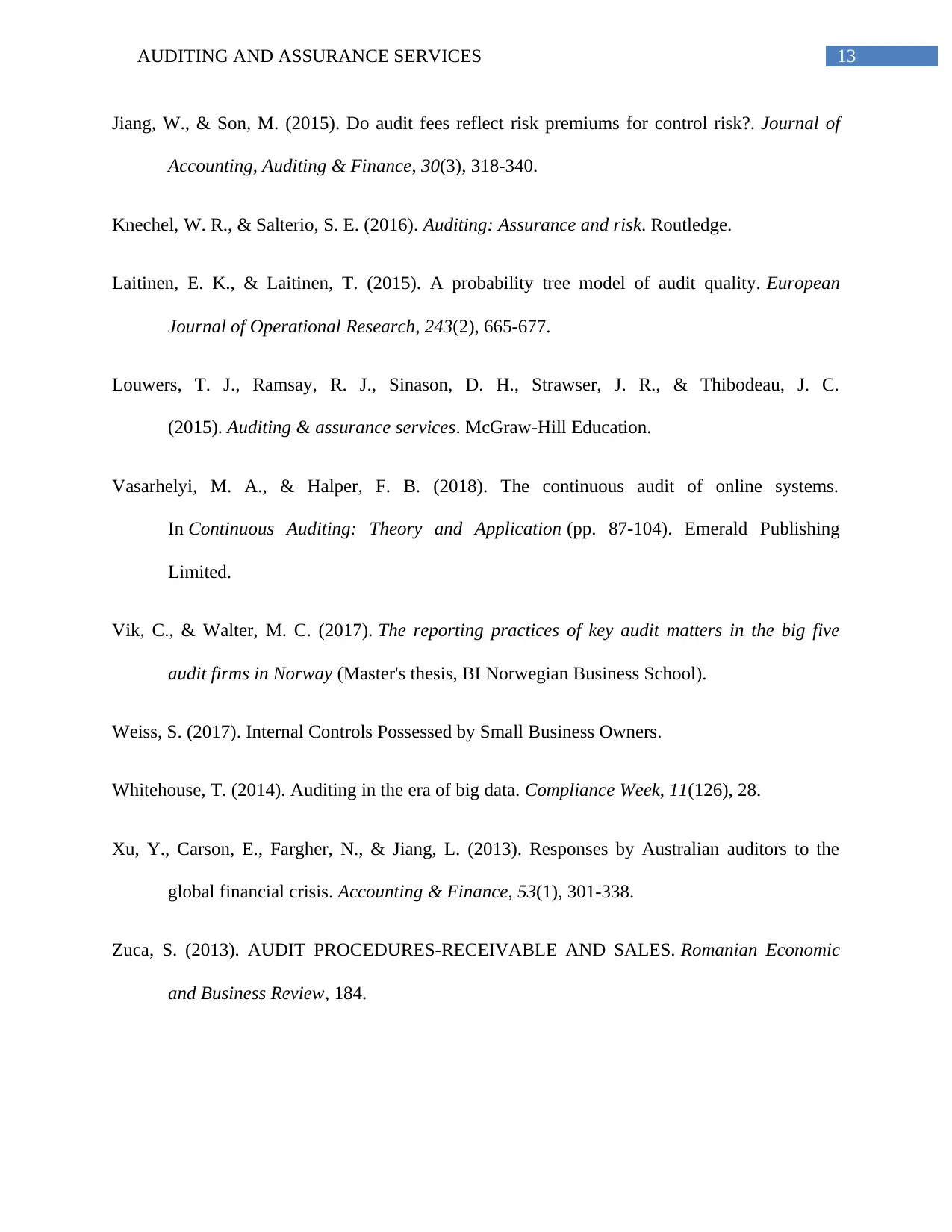
13AUDITING AND ASSURANCE SERVICES
Jiang, W., & Son, M. (2015). Do audit fees reflect risk premiums for control risk?. Journal of
Accounting, Auditing & Finance, 30(3), 318-340.
Knechel, W. R., & Salterio, S. E. (2016). Auditing: Assurance and risk. Routledge.
Laitinen, E. K., & Laitinen, T. (2015). A probability tree model of audit quality. European
Journal of Operational Research, 243(2), 665-677.
Louwers, T. J., Ramsay, R. J., Sinason, D. H., Strawser, J. R., & Thibodeau, J. C.
(2015). Auditing & assurance services. McGraw-Hill Education.
Vasarhelyi, M. A., & Halper, F. B. (2018). The continuous audit of online systems.
In Continuous Auditing: Theory and Application (pp. 87-104). Emerald Publishing
Limited.
Vik, C., & Walter, M. C. (2017). The reporting practices of key audit matters in the big five
audit firms in Norway (Master's thesis, BI Norwegian Business School).
Weiss, S. (2017). Internal Controls Possessed by Small Business Owners.
Whitehouse, T. (2014). Auditing in the era of big data. Compliance Week, 11(126), 28.
Xu, Y., Carson, E., Fargher, N., & Jiang, L. (2013). Responses by Australian auditors to the
global financial crisis. Accounting & Finance, 53(1), 301-338.
Zuca, S. (2013). AUDIT PROCEDURES-RECEIVABLE AND SALES. Romanian Economic
and Business Review, 184.
Jiang, W., & Son, M. (2015). Do audit fees reflect risk premiums for control risk?. Journal of
Accounting, Auditing & Finance, 30(3), 318-340.
Knechel, W. R., & Salterio, S. E. (2016). Auditing: Assurance and risk. Routledge.
Laitinen, E. K., & Laitinen, T. (2015). A probability tree model of audit quality. European
Journal of Operational Research, 243(2), 665-677.
Louwers, T. J., Ramsay, R. J., Sinason, D. H., Strawser, J. R., & Thibodeau, J. C.
(2015). Auditing & assurance services. McGraw-Hill Education.
Vasarhelyi, M. A., & Halper, F. B. (2018). The continuous audit of online systems.
In Continuous Auditing: Theory and Application (pp. 87-104). Emerald Publishing
Limited.
Vik, C., & Walter, M. C. (2017). The reporting practices of key audit matters in the big five
audit firms in Norway (Master's thesis, BI Norwegian Business School).
Weiss, S. (2017). Internal Controls Possessed by Small Business Owners.
Whitehouse, T. (2014). Auditing in the era of big data. Compliance Week, 11(126), 28.
Xu, Y., Carson, E., Fargher, N., & Jiang, L. (2013). Responses by Australian auditors to the
global financial crisis. Accounting & Finance, 53(1), 301-338.
Zuca, S. (2013). AUDIT PROCEDURES-RECEIVABLE AND SALES. Romanian Economic
and Business Review, 184.
1 out of 14
Related Documents
Your All-in-One AI-Powered Toolkit for Academic Success.
+13062052269
info@desklib.com
Available 24*7 on WhatsApp / Email
![[object Object]](/_next/static/media/star-bottom.7253800d.svg)
Unlock your academic potential
© 2024 | Zucol Services PVT LTD | All rights reserved.




